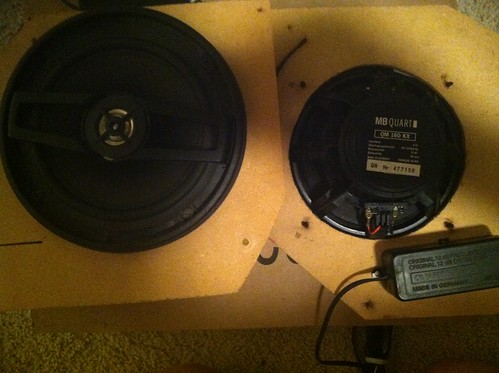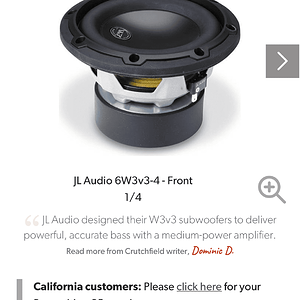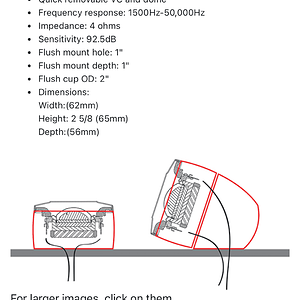bbeljefe
CarAudio.com Elite
I'm not telling you not to use a DMM... it's your system and you can use a yard stick to set your gains if you like. I'm just sharing information to the best of my knowledge in the hopes that people are able to learn as much as possible about this hobby/obsession some of us have. ;-)I got it,.. honestly, understood all of it. I do know what a Sine wave looks like,.. and with my research and online classes I've learned the patterns of the wave.. How, let's just say on the headunit (I'll have the 12v from the battery (again a generalization.. I know voltages differ) -- The middle of the "rails" would be 6v,.. the bottom of the sine wave 0v (ground), and the top crest +12v. -- So take that middle of the rail in the headunit at 6volts.. and apply 6vp/sqrt(2) = 4.2 Volts, thus this would be the 4v Signal coming from the pre-out(s) (Again, I know this voltage isn't going to be this perfect theoretical 4.2v) -- It goes into the Amp which then , well, amplify's this voltage and so on.
Now, if DMM's were as easy as I make it sound to dial in a system,.. then there wouldn't be O-scopes and other equipment to adjust a system from the amp to EQ's , crossovers, et al.
That said,.. If I buy an amp with some headroom. Let's say I need 100watts RMS (as the speaker is rated (and it's a quality speaker) ).. and the amp I purchase is a quality amp that can push 150watts on that channel,.. That leaves some decent headroom (and the way I see it.. a little room for error, given I'll be dialing in with a DMM). So in this example,.. if I set this headunit AVH-P4100DVD - In-Dash Double-DIN DVD Multimedia AV Receiver with 7" Widescreen Display | Pioneer Electronics USA Which is the headunit I have installed to 75% (some say go 80-90%.. most say 75%).. volume,.. set bass/treble to 0/zero and I suppose set the Parabolic EQ flat? -- Then have the amp gain on zero to start. Put in 1khz Sine wave tone off a CD (or usb stick) that plays for 5 minutes straight.. and go to the amp positive terminal, stick the DMM on the positive terminal,.. and slowly move up the gain for this channel(s) until my DMM reads 20v on the nose,.. And I'm obviously listening at the same time,.. and no distortion is audible,.. Then perhaps I put in a clean song.. (I know music //content.invisioncic.com/y282845/emoticons/smile.gif.1ebc41e1811405b213edfc4622c41e27.gif ) -- and listen closely to it,.. That should be a reasonably safe way to dial in the amp given I don't have the O-scope or other such tools, no?
Then for the sub I'll repeat process, but play a 40hz sine wave .. And adjust the sub channel(s) gain for voltage for 4ohms at Subs RMS rating -- Let's just use 100watts RMS on an 8" sub for ease of math, and coincidentally it would be the same voltage rating as the front speaker(s),.. to 20.00v on the DMM,.
That's the only way I know how to do it without several hundred to several thousand dollar equipment that would obviously be foolish for me to purchase. I'd love to have a scope where I can watch the Wave in real time.. to ensure the peaks and troughs don't flatten out (clip).
I've heard people tell me that going to the "trouble" of using a DMM and doing what I just described as being a waste of time.. to set everything where it distorts then back down just slightly and you are done.
In my opinion,.. spending 10 minutes or so adjusting voltage playing a tone that's right for the speaker type (be it a mid/high/ or sub) and having a DMM on the positive terminal and taking my time adjusting the gain from zero up to voltage is not a waste of time,.. nor difficult. Why chance it? Why not dial it in the best you can with the tools and knowledge you have?
Aside from having the O-scope or other tools needed to really see what is going on,.. I am left with little choice other than to bring the car to a shop that does have these tools (which I'm willing to bet quite a few don't even have them.. and adjust by ear, or at best with a DMM.. but that's a guess) and tell them, I need my amp dialed in please.. and pay them $100 or whatever fee they would charge.
I agree with you! I understand, granted at an early stage of learning these principles, the dynamics going on and why using just voltage readings doesn't guarantee me "Safety" or even being at the right gain for my needs -- But, am I wrong in the broad generalization that purchasing a/an Quality amp with say 50% headroom (or more) over the RMS rating of the Quality speakers gives me a better chance of dialing it in using the DMM without introducing distortion and/or clipping into the equation?
You obviously know the science of this quite well, and are used to doing it the proper/best way possible -- It shows by your responses, and you being the OWNER of Audio Anarchy //content.invisioncic.com/y282845/emoticons/wink.gif.608e3ea05f1a9f98611af0861652f8fb.gif -- However, I am trying to do things "right" the best way I can with what I have available to me. I also know just because X percent of people dial in their amp gains by ear, or at best with a DMM (some maybe not even really knowing what they are doing or why).. doesn't mean that because they do it this way that so can I, and be trouble free.
I just feel fairly confident in buying a quality amp that has SOME headroom in it,.. with quality components and proper passive crossovers, and a headunit that I linked above that from what I've read in it's specs puts out a great, clean, 4v signal (It's not the best in the world.. but it's certainly mid range I would say) -- That dialing it in with the DMM with the tones I mentioned should produce a safe environment for my setup.
If not, let me know. This is a bit odd, cause I am not overthinking this part -- I am solid and confident in purchasing the components as mentioned and using the method I explained,.. and you are informing me.. "Hey not so fast.. !" //content.invisioncic.com/y282845/emoticons/biggrin.gif.d71a5d36fcbab170f2364c9f2e3946cb.gif
You are 'somewhat' close to me.. as I am in Birmingham, AL -- but it's still a 6+ hour drive. If you were say 2 hours away, I'd say screw all this and come to your place and let you help me pick out everything and have your employees install it all. Unfortunately you are nearly 7 hours away, so best I can do is take your advice.
Thanks for all the help,
And I'm also not trying to send you to a store that can't do any better than you can (and trust me, you have a better understanding of this than a plurality of installers), nor am I asking you to drive to my store.
That said, the DMM method is not reliable. ← Dead horse, I know. But that's not to say it can't or shouldn't be used in the absence of the proper equipment, because it will certainly get you closer than the by ear method. But again, if there is any distortion in the system, it won't detect it, regardless of how far below the rails you set the gain... and a clipped signal is not good even when it isn't on the rails.
With all that said, here's what I would do if I were forced to use a DMM for gain setting. First, I'd try to find out if someone else has tested my head unit model for clipping. A google query works well. If I found that information, that's where I'd set it and if not, Id set it at ~80% with all tonal controls and eqs flat, and with no crossovers set. Also, no loudness contours or bass boost circuits on an I would find out if my subwoofer level control had a boost circuit or if, when turned all the way up, it was at 0dB. And then I'd set it at whatever the 0dB point is.
I'd go to D'Amore Engineering's website and download the DD-1 CD test tracks (free), most importantly tracks 1 & 2 which are 40Hz @ 0dB and 1kHz @ 0dB. I'd use those tracks because they are known to be clean. Then I'd set the amplifier crossovers, bass boosts, et al just like I did the head unit's and I would disconnect all speakers.
And then, of course, I'd go about setting the gain to max output less one or two volts. That would be as close to accurate as I could get while still taking advantage of my amplifiers' potential.
Just an afterthought or two... when you hear distortion, it has been a problem for a while. This is why the "by ear" method is not advisable. All of the Pioneer head unit's I've tested have clipped at 48 or 9 on the volume scale or, ~80% but, I've not tested yours. Lastly, if you're a member of Steve Meade's forum, there is a thread that has a tool map of sorts which shows various people all over the world who own oscopes, distortion detectors and other test equipment. I know there are some of those people in Alabama and a lot of them will help you for gas money, beer or ~$25.00. Some will help for free.



